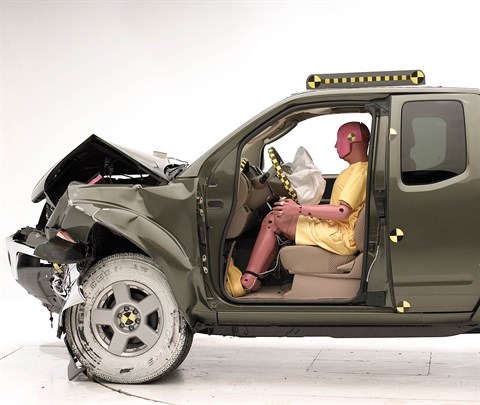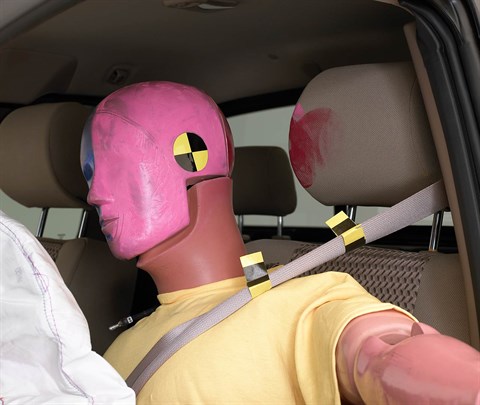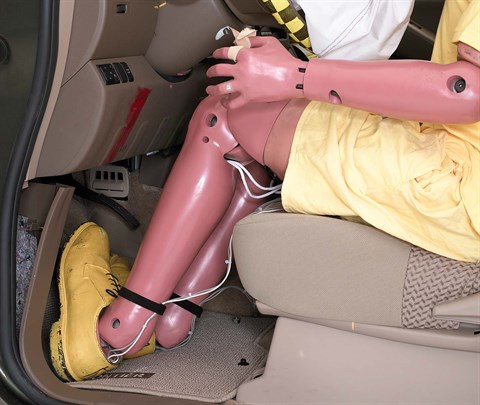Moderate overlap front: original test
Rating applies to 2005-12 models
Tested vehicle: 2008 Nissan Frontier SE Crew Cab
The Nissan Frontier Crew Cab and King Cab were redesigned for the 2005 model year and are significantly larger and heavier than previous models. The Suzuki Equator Crew Cab and Extended Cab were introduced in the 2009 model year. Two tests of the Frontier were conducted, one by the Institute of a 2wd King Cab and the other by Nissan of a 2wd Crew Cab. The overall rating of Good is based on review of both tests, which independently result in overall ratings of Good. The ratings and vehicle specifications based on Nissan's test are shown below because the 2wd Crew Cab is similar to the configuration of other pickups tested more recently.
| Evaluation criteria | Rating |
|---|---|
| Overall evaluation | |
| Structure and safety cage | |
| Driver injury measures | |
| Head/neck | |
| Chest | |
| Leg/foot, left | |
| Leg/foot, right | |
| Driver restraints and dummy kinematics | |

Action shot taken during the Institute's frontal offset crash test.

The dummy's position in relation to the steering wheel and instrument panel after the crash test indicates that the driver's survival space was maintained well (Institute test vehicle shown).

Dummy movement was well controlled in both tests. During rebound, the dummy's head hit only the head restraint.

In both tests, forces on the left knee and the right lower leg were high enough to indicate the possibility of injuries (Institute test shown).
Measures of occupant compartment intrusion on driver side
| Evaluation criteria | Measurement | |
|---|---|---|
| Test ID | CEF0504 | VTF0812 |
| Footwell intrusion | ||
| Footrest (cm) | 11 | 12 |
| Left (cm) | 12 | 13 |
| Center (cm) | 14 | 15 |
| Right (cm) | 12 | 13 |
| Brake pedal (cm) | 7 | 6 |
| Instrument panel rearward movement | ||
| Left (cm) | 1 | 0 |
| Right (cm) | 1 | -1 |
| Steering column movement | ||
| Upward (cm) | 4 | 3 |
| Rearward (cm) | 0 | 1 |
| A-pillar rearward movement (cm) | 2 | 3 |
Driver injury measures
| Evaluation criteria | Measurement | |
|---|---|---|
| Test ID | CEF0504 | VTF0812 |
| Head | ||
| HIC-15 | 255 | 252 |
| Peak gs at hard contact | no contact | no contact |
| Neck | ||
| Tension (kN) | 1.5 | 1.4 |
| Extension bending moment (Nm) | 21 | 19 |
| Maximum Nij | 0.25 | 0.24 |
| Chest maximum compression (mm) | 34 | 35 |
| Legs | ||
| Femur force - left (kN) | 1.4 | 2.0 |
| Femur force - right (kN) | 0.0 | 1.0 |
| Knee displacement - left (mm) | 13 | 14 |
| Knee displacement - right (mm) | 0 | 2 |
| Maximum tibia index - left | 0.95 | 1.05 |
| Maximum tibia index - right | 0.35 | 0.58 |
| Tibia axial force - left (kN) | 2.4 | 3.2 |
| Tibia axial force - right (kN) | 4.3 | 4.4 |
| Foot acceleration (g) | ||
| Left | 111 | 140 |
| Right | 117 | 162 |
Head restraints & seats
Seat type: Seats without adjustable lumbar AHR
| Overall evaluation | |
|---|---|
| Dynamic rating | |
| Seat/head restraint geometry |
| Seat type | Seats without adjustable lumbar AHR |
|---|---|
| Geometry | |
| Backset (mm) | 80 |
| Distance below top of head (mm) | 50 |
| Seat design parameters | |
| Pass/fail | Fail |
| Max T1 acceleration (g) | 12.8 |
| Head contact time (ms) | 81 |
| Force rating | 3 |
| Neck forces | |
| Max neck shear force (N) | 195 |
| Max neck tension (N) | 876 |
Seat type: Seats with adjustable lumbar AHR
| Overall evaluation | |
|---|---|
| Dynamic rating | |
| Seat/head restraint geometry |
| Seat type | Seats with adjustable lumbar AHR |
|---|---|
| Geometry | |
| Backset (mm) | 65 |
| Distance below top of head (mm) | 58 |
| Seat design parameters | |
| Pass/fail | Fail |
| Max T1 acceleration (g) | 11.3 |
| Head contact time (ms) | 73 |
| Force rating | 3 |
| Neck forces | |
| Max neck shear force (N) | 302 |
| Max neck tension (N) | 1,477 |
About the head restraint & seat test
Currently, IIHS tests apply only to front seats.